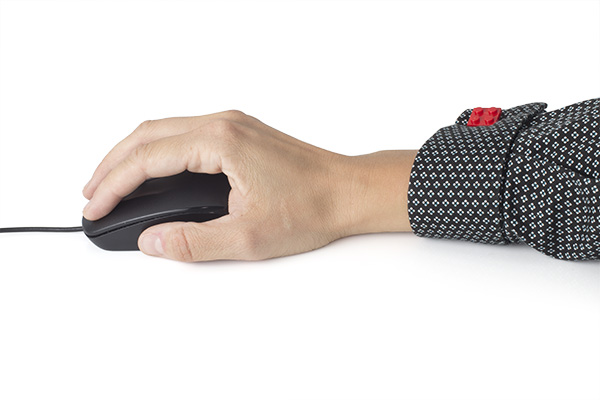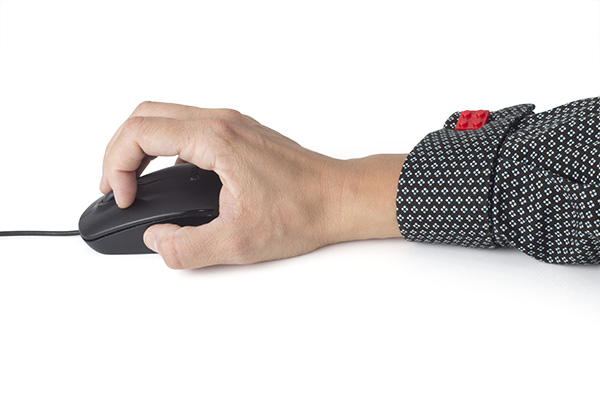Are You Doing it Right? How To Correctly Use a PC Keyboard and Mouse
24 August 2017
Over the years, many of us find ourselves spending an increasing amount of time in front of a computer. While this can bring many benefits, from reconnecting with old friends or researching an exciting topic, it can also be detrimental to our physical health.
Most of us rely on using a standard PC keyboard and mouse to navigate our way around the desktop, though it's more than likely that we don't really stop to think about what we're doing with our hands as we type or scroll. If your techniques when using a keyboard and mouse are not ideal, this can cause some serious long-term problems for your wrists.
We've compiled this guide to help you understand what problems poor mouse and keyboard techniques can cause, and how to prevent as far as possible the related conditions from developing.
What Are the Risks of Improper Technique?
Chances are, when you were taught to use a computer, whether at home or at school, the focus was on the workings of the PC itself, rather than how you control the input devices such as the keyboard and the mouse. However, while it is useful to know how to load up the internet or discard an old file in the trash, learning how to correctly position your hands and wrists while browsing and typing can significantly improve your wrist health.
There are a range of conditions that can develop as a result of poor wrist positioning and movement. General wrist weakness can manifest early on, presenting itself with either a constant or intermittent pain that can be both uncomfortable and unbearable. This weakness can also progress to more challenging conditions such as repetitive strain injury (RSI) and carpal tunnel syndrome (CTS), which can be difficult and time-consuming to treat.
These conditions can be debilitating, and may seriously hinder your quality of life. If you feel you have already developed a wrist condition, follow the link below to our Knowledge Centre, where you can find out a wide range of information and advice on how to treat these ailments.
How To Use a Mouse
Just as every computer user is different, everybody's default hand and wrist positioning on a PC mouse will differ. While there is no 'correct' way to hold a mouse, there are certain methods that can be adopted in order to ensure you can protect your wrist and keep it as healthy as possible.
Following the steps outlined below, you can rest assured that you have taken every measure possible to prevent the development of debilitating wrist conditions as a result of poor mouse techniques.
- Use a mouse mat. One of the main reasons your wrist may be overworking is due to the inability of the mouse to manoeuvre smoothly. Depending on the surface of your desk or work area, the mouse may struggle to move with ease. A mouse mat can help the mouse to detect this movement, whether though the use of a trackerball or sensor, which in turn will allow your wrist to relax a little more.
- Palm grip for low sensitivity. The palm grip involves resting the palm in the back of the mouse, while positioning the index finger on the left-click button and the middle finger on the right-click button. The wrist, and in turn the mouse, should feel like an extension of the forearm, and should not be bent uncomfortably or nearing perpendicularity.
- Claw grip for high sensitivity. Particularly useful for anybody who frequently plays computer games, adopting the claw grip positioning will provide you with higher sensitivity, increasing your agility and control over the mouse. This involves placing the base of your palm on the back of the mouse, and poising your fingertips on the left and right buttons while gripping the mouse with your thumb and pinkie finger.
- Scroll with ease. The scroll wheel in between the two click buttons can cause a lot of finger and wrist pain if used uncomfortably. The easiest way is to use the index finger; moving this finger between the left-click button and the scroll wheel will also help your hand from being stuck in one position!
- Take regular rest breaks. When using a computer, it's important that you take regular breaks. This is partly because the glare from the screen can cause a strain on your eyes, but it is also necessary to ensure that your posture does not become too rigid or too slack. By giving your hand and wrist a rest from the mouse, it reduces the risk of developing such conditions as RSI.
- Wear a brace. Finally, you may choose to wear a wrist brace or support if you are going to be spending long periods of time at the computer, or if you already have a weak wrist and would like to protect it from further damage. You can view our full range of wrist braces at WristSupports.co.uk by clicking here.

Mouse with palm grip hand position

Mouse with claw grip hand position
How To Use a Keyboard
You may think that, since using a computer keyboard involves pressing lots of different keys, there is minimal risk of harm to the hands and wrists. However, typing can put a lot of pressure on the performance of your hands, and developing bad habits can, in the long run, have debilitating consequences for the health of your wrist.
By following some, or even all, of the directions below, you can encourage improved wrist health and stronger performance that can both help to prevent wrist injury and reduce the effects of existing conditions.
- Proper posture. Before we even think about what our hands are doing, we should take note of how we're sitting, as this can by default cause our wrists to be angled awkwardly. Your back should be straight, but not stiff, with the seat positioned at a height that is comfortable for you. Your eyes should be in line with the part of the document with which you're concerned, ideally about a third of the way down the screen, and you should be sitting with the keyboard close to you.
- Use a wrist rest. If you are going to be typing for a while, you may benefit from using a keyboard wrist rest. This can be positioned in front of the keyboard to provide cushioning beneath your wrists, taking the strain away from keeping them positioned upright while you work. Wrist rests can also be purchased for the mouse, and are available in a range of comfortable materials, colours, and designs.
- Use all 10 fingers. Chances are, even if you don't type with just your index fingers, you will know somebody who does. This typing with just the one finger on each hand can cause problems for all fingers, hands, and wrists; thus it is advised that you type with as many fingers as possible. While this will enable you to move your fingers more quickly around the keyboard, it will also flex each one in turn so that pressure is not placed on any individual digit.
- Utilise Num Lock. Many keyboards, particularly desktop keyboards, feature a small section on the right-hand side known as the numeric keypad. This can be used by activating the 'Num Lock' button, which is usually situated above the number '7', and, by using this instead of the numbers that are written across the top of the keyboard, it will prevent the wrist from stretching far away from the mouse. Left-handed keyboards can also be purchased, with the numeric keypad on the left of the board.
- Wear a brace. As we learned with the mouse, wearing a wrist brace can also significantly reduce any pain and discomfort that may arise when typing at the computer. Some wrist braces offer compression and added support, while others specialise in stabilising and even immobilising the wrist area, preventing you from bending it awkwardly. While it may feel peculiar to type with the wrist in a brace, it can save you a lot of trouble in the long run. You can view our full range of wrist braces and supports by following this link.
- Learn shortcuts. If you are a seasoned typist, then you will probably already be aware of some keyboard shortcuts. These shortcuts enable you to perform certain functions, such as copying, pasting, saving, and even undoing actions that you didn't mean to perform! These can not only save you time, but will also reduce the amount of striking your fingers do against the keys while encouraging them to perform together by pressing multiple keys at once. Below is an example of some of the shortcuts that can help you; each key is pressed alongside the CTRL button to active the required shortcut.

By adopting some of these techniques when using the mouse and keyboard, you can rid yourself of some of those years-old bad habits and develop a new, healthier approach to computing. Not only will this encourage strengthening of your wrists by effectively working them over time with different tasks, but it can also reduce any pain and discomfort, while also minimising the risk of other conditions developing.
We would love to know how you got on with trying out some of these techniques! Why not leave us a comment below or find us on Facebook or Twitter.



